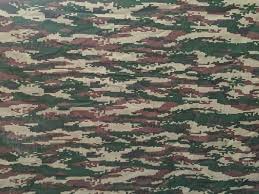As you all know army uniform is changed recently on Jan 15 which was Army day and here we have given some insight on this new uniform.
- The New Combat Uniform has been designed by the National Institute of Fashion Technology (NIFT) in close coordination with the Army.
- The uniform was designed by a team of 12 people which included seven professors, three students, and two alumni.
- The Combat Uniform was created through a consultative process with the Army, keeping in mind the “4Cs” — comfort, climate, camouflage, and confidentiality.

Purpose:
The uniform has been designed to serve two requirements:
a) protection against harsh climatic conditions, including extreme heat and cold
b) To provide soldiers’ outfits with field camouflage, so as to increase battlefield survivability.
The digital descriptive pattern: It’s the new trend in camouflage designs to have a lot of little random squares instead of a lot of huge random squiggles. Any camouflage pattern created with the help of a computer is referred to as “digital camouflage.” You feed the computer information on what colours to expect and in what percentages, and the computer generates a pattern. This design is refined and refined until it is attractive to the eye.

History:
Digital camouflage provides a disruptive effect through the use of pixellated patterns at a range of scales, meaning that the camouflage helps to defeat observation at a range of distances. Such patterns were first developed during the Second World War, when Johann Georg Otto Schick designed a number of patterns for the Waffen-SS, combining micro- and macro-patterns in one scheme. The German Army and The Soviet Army developed the idea further more.
Later US Army officer Timothy R. O’Neill suggested that patterns consisting of square blocks of colour would provide effective camouflage. By 2000, O’Neill’s idea was combined with patterns like the German Flecktarn to create pixellated patterns such as CADPAT and MARPAT. Battledress in digital camouflage patterns was first designed by the Canadian Forces. The “digital” refers to the coordinates of the pattern, which are digitally defined. The term is also used of computer generated patterns like the non-pixellated Multicam and the Italian fractal Vegetato pattern. Pixellation does not in itself contribute to the camouflaging effect. The pixellated style, however, simplifies design and eases printing on fabric.

Improvements:
The main changes in the new uniform, compared to the old one that has been in use since 2008, are with regard to the camouflage pattern, design, and the use of a new material. While the new unique camouflage pattern retains the combination of the same colours — olive green and earthen shades — the pattern is digital now. It has been designed keeping in mind the many kinds of operational conditions that the soldiers function in, from deserts to high-altitude areas, jungles and plains. The fabric for the new material makes it lighter, sturdier, more breathable, and more suitable for the different terrains that soldiers are posted in. The cotton-to-polyester ratio is 70:30, making it quicker to dry, more comfortable to wear in humid and hot conditions, and lightweight. According to the Army, it is an ergonomically designed, operationally effective, new-generation camouflage combat uniform. The fabric is 15 per cent lighter, and has 23 per cent more strength against tearing, against the current uniform.
The ergonomic features allow for long-hour use and comfort, and micro features are inbuilt for the use of the wearer in field conditions. The new uniform has a mix of Olive Green and earthy colours for better camouflage and the fabric is durable, sturdier and lighter than the ones used earlier.
The pattern of the Indian Army’s new uniform is widely used by troops abroad and is engineered to withstand tough conditions like harsh temperatures, explosive bursts, and fluctuating air pressures and is supposed to provide the soldiers more comfort. The new combat uniform is also eco-friendly. It even resembles the modified version of the Canadian CADPAT camouflage pattern that was rolled out to the US Army, US Airmen in the Middle East and Air Force Global Strike Command security forces.